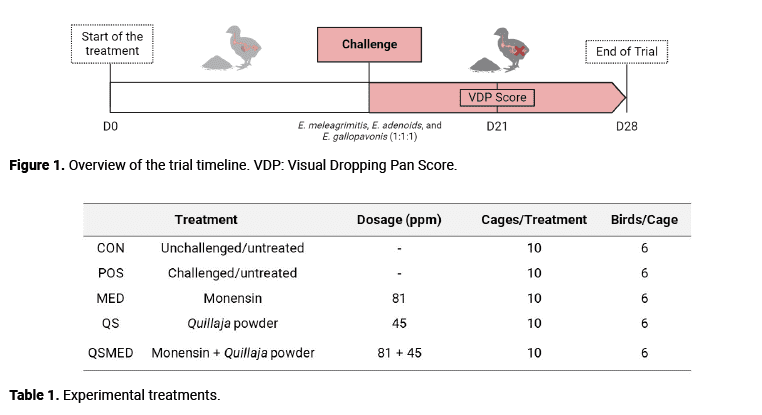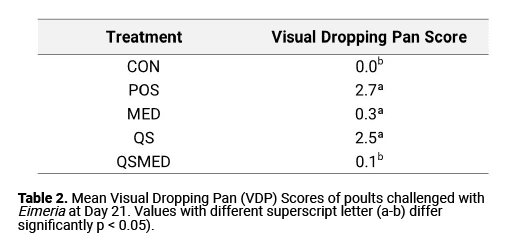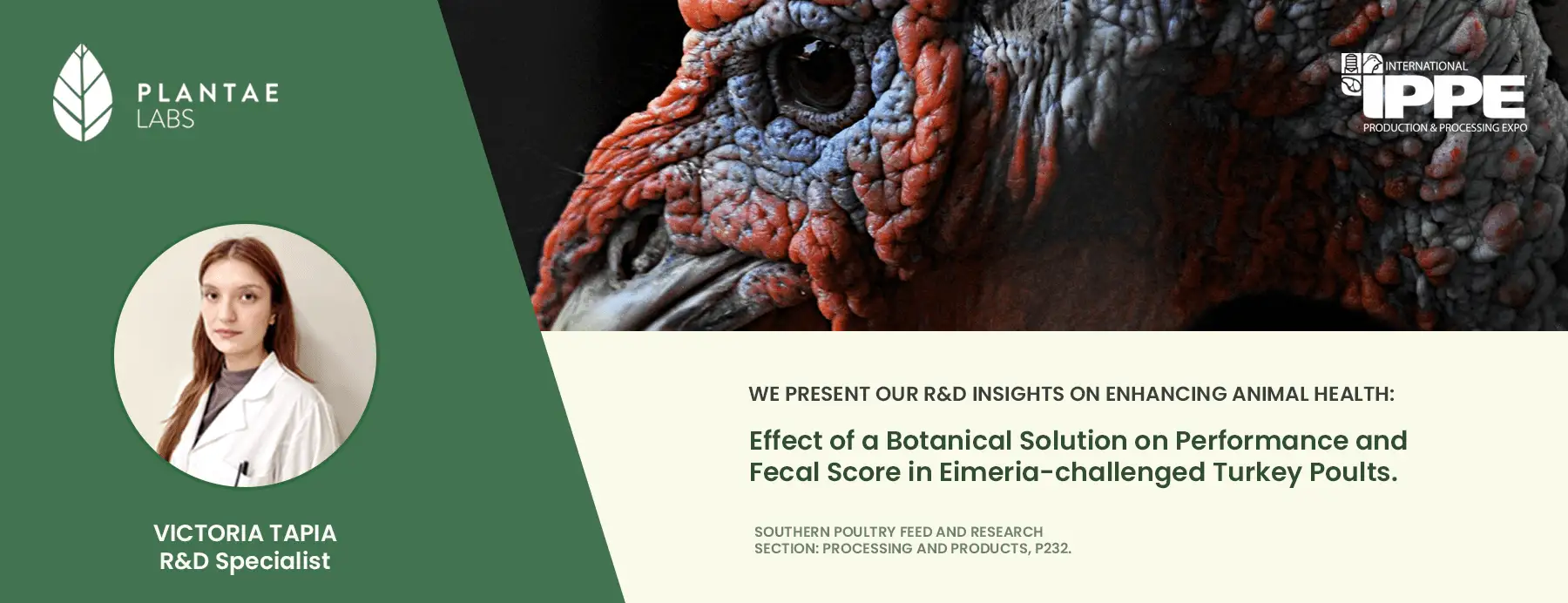Effect of a Botanical Solution on Performance and Fecal Score in Eimeria- challenged Turkey Poults.
INTRODUCTION
Coccidiosis is a major poultry disease caused by protozoan parasites of the genus Eimeria also called coccidia. Coccidia infects the turkey’s intestinal tract, leading to a significant impact on their health and the increasing costs associated with reduced performance, prevention, control, and mortality. With the rise of antimicrobial resistance, there is a pressing need for a new generation of natural solutions able to mitigate the widespread dissemination of resistance and preserve beneficial microbiota.
Objective. To evaluate the anticoccidial efficacy of a natural encapsulated feed additive against current turkey coccidia field isolates.
__________
METHODS
Experimental animals. A total of 300 day-of-hatch Nicholas Select male turkey poults were randomly allocated into 50 cages (10 cages per treatment) with 6 birds per cage (Table 1).
Experimental design. Ten blocks were designated for each of the five dietary treatments: Monensin (MED); Quillaja saponaria extract powder (QS), and a combination of QS (QSMED). All treatments were administered from Day 0 to Day 28 (Table 1).

On Day 14, all birds except CON were individually inoculated by oral gavage with 30,000 oocysts/ ml with a mixture of E. meleagrimitis, E. adenoids, and E. gallopavonis field isolates (1:1:1). Feed intake (FI) and body weights (BW) were recorded on Days 0, 14, and 28. Fecal samples were collected on Day 21 for evaluation using a Visual Dropping Pan (VDP) score. Dead birds were registered and removed for necropsy along with the assay to determine the probable cause of death (Fig. 1).
Statistical Analysis. The data were analyzed by Analysis of Variance and Tukey’s Test, using Statistix 10.0 software.
RESULTS
The effects of the Eimeria challenge were clear. POS-group poults had lower BWG and higher FCR than unchallenged birds. The CON group did not present alterations in the fecal evaluation, while the POS group showed the highest Visual Dropping Pan score of the treatments (Table 2).
Supplementation with QS between D0-28 improved BWG and FCR by 7% compared to POS. However, QS was not highly effective as MED, which increased BWG and reduced FCR significantly (p<0.05) compared to the untreated group at D0-28. Birds supplemented with QS and MED showed a better performance than POS during the same period. QSMED supplementation increased BWG by 26% and significantly improved FCR by 21% compared to POS (Fig 1.A). These findings align with prior research (Blue et al., 2023), showing the improvement of BWG and FCR with saponin supplementation. Additionally, QS enhances the effect of MED, which is consistent with other studies (Li & Monje- Galvan, 2023; Antolak et al., 2018).

Performance at D14-28 was similar. BWG in QS-supplemented birds was significantly (p<0.05) higher than in the POS group, with an 11% increase. QS also improved FCR by 5% compared to POS. In the same period, QSMED supplementation showed a 40% and 24% improvement in BGW and FCR, respectively, compared to the untreated/challenged group (Fig 1.B).
The VDP scores align with the observed productive parameter outcomes. All treatments reduced VDP scores, with QS decreasing scores by 7% compared to POS. QSMED had a significant (p<0.05) impact on scores, showing a 96% and 33% reduction compared to POS and MED, respectively (Table 2). No mortalities were recorded for any of the treatments.

CONCLUSION
In conclusion, the Quillaja saponaria extract powder not only improved the performance of turkey poults under Eimeria challenge conditions but also enhanced the effects of monensin (MED) under the same challenge conditions. QS is an effective solution to mitigate the coccidial infection impact on poults performance and as an enhancer to current treatment tools.
____________
1. Antolak, H., Mizerska, U., Berłowska, J., Otlewska, A., & Kręgiel, D. (2018). Quillaja saponaria Saponins with Potential to Enhance the Effectiveness of Disinfection Processes in the Beverage Industry. Applied Sciences, 8(3), 368. https://doi.org/10.3390/app8030368
2. Blue, C. E. C., Emami, N. K., White, M. B., Cantley, S., & Dalloul, R. A. (2023). Inclusion of Quillaja Saponin Clarity Q Manages Growth Performance, Immune Response, and Nutrient Transport of Broilers during Subclinical Necrotic Enteritis. Microorganisms, 11(8), 1894. https://doi.org/10.3390/microorganisms11081894 3. Li, J., & Monje-Galvan, V. (2023). In vitro and in Silico Studies of Antimicrobial saponins: a review. Processes, 11(10), 2856. https://doi.org/10.3390/pr11102856


